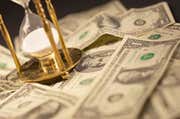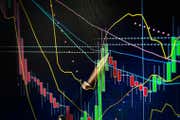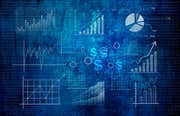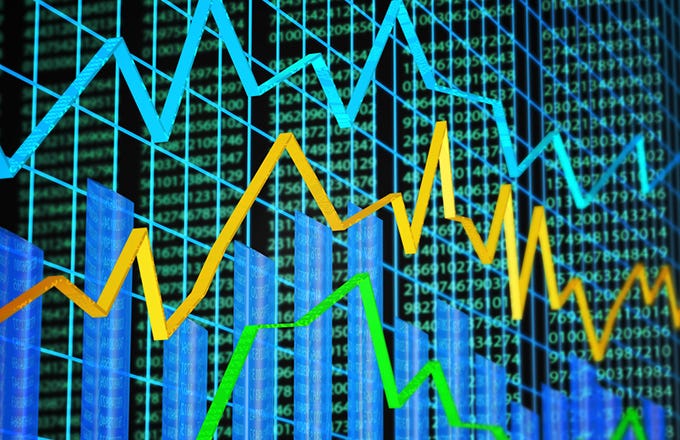For citizens of different countries to conduct trade, they have to buy and sell each other's currencies. The price of a nation's currency, expressed as an amount of a second country's currency, is referred to as the exchange rate. As exchange rates play a significant role in trade and capital flows, it is an important concept in macroeconomics.
The nominal exchange rate is the type of exchange rate that is referenced most often in business discussions. When reports talk of the dollar being worth 1.35 euros or 85 Japanese yen, they are referring to the nominal exchange rate. The real exchange rate is a bit more academic – it is the amount of goods or services from one country that can be traded for another country's goods and services. It can be expressed as the equation: (nominal exchange rate x domestic price) / foreign price.
There are basically two types of international exchange rate systems – fixed and floating. In a fixed exchange system, countries establish the ratio of their currencies and then commit to maintaining those rates. A country supports fixed rates by buying (or selling) foreign reserves in response to changes in demand for the currency.
From day to day, there is minimal change in a fixed rate system – if the exchange rate between dollars and euros is fixed at 1:1.25, businesses, governments and individuals can typically count on that rate being in force at any given time. This is often seen as convenient for companies conducting international trade as it removes the risk and unpredictability of exchange rates.
Fixed rates were commonplace throughout the 19th and 20th centuries, with gold serving as the underlying standard and the British pound serving as the global reserve currency (in other words, almost all countries would accept gold or British pounds to settle accounts). Near the end of World War 2, the Bretton Woods Agreement came into being and largely governed foreign exchange rates into the early 1970s, with fixed rates and the U.S. dollar becoming the new world reserve currency. In practice, most countries have found that a fixed exchange system is too limiting and too expensive to maintain, and as of the early part of the 21st century, China is the only major economy to maintain such a system. (For more on fixed exchange rates, check out The Pros And Cons Of A Pegged Exchange Rate.)
In contrast, a country can elect to allow the market to set the value of its currency. This is called a floating exchange rate system. If a country has floating exchange rates, foreign exchange rates are subject to the same rules of supply and demand as any other good. When there is increased demand for a currency, its value increases relative to other currencies. This demand can be driven by consumer tastes (a preference for goods from that country), relative incomes, relative inflation and outright speculation.
Not surprisingly, exchange rates are typically much more volatile in a floating environment; some economists have estimated that rates have been at least twice as volatile since the end of the Bretton Woods system. (To learn more about the difference of fixed and floating exchange rates, read Currency Exchange: Floating Rate Vs. Fixed Rate.)
What determines exchange rates?
One theory, called purchasing power parity (PPP), holds that the ratio of two countries' exchange rates should equal the ratio of the prices of identical goods in those two countries. If a gold coin is worth $1 in the United States and the same gold coin would be worth 100 yen in Japan, PPP says that the exchange rate should be $1:100Y. By extension, then, purchasing power parity also holds that changes in relative inflation rates tie into changes in exchange rates.
This theory works mathematically and logically; if there was not such a state of parity, one could buy goods in the "cheap" country, sell them in the more expensive country and reap risk-free profits.
In the real world, though, this theory does not strictly hold true. Not only are there expenses involved in shipping, but there are various trade barriers and tax issues involved. What's more, the notions of specialization and comparative advantage suggest that goods are not exactly the same – some countries can produce goods at lower cost than other countries. Still, when considering price levels on the whole this is less problematic and the theory is somewhat more useful.
One well-known application of purchasing power theory is the Big Mac Index. Created by The Economist, the Big Mac Index evaluates the under/overvaluation of foreign currency relative to current rates by examining the price of a Big Mac in various countries. In concept this should be a reasonably fair test of purchasing power theory, though local taxes, regulations and farm policy to influence the comparisons. (For more on purchasing power parity, see Hamburger Economics: The Big Mac Index.)
Likewise, the interest rate parity concept is a useful theoretical construct that does not hold true in practice. In essence, interest rate parity holds that the returns from borrowing money in one currency (say dollars), exchanging it for another (yen), investing that currency in interest-earning assets denominated in that second currency (yen-denominated bonds), and purchasing a futures contract to convert back to dollars at maturity of the asset (the bonds) will be equal to simply buying and holding like interest-bearing assets in the original currency (a dollar-denominated bond in this case).
This concept implies that the differences in nominal interest rates correspond to the difference in rates of change of exchange rates. Now it is certainly true that there is a relationship between interest rates and foreign currency exchange rates. There is a phenomenon in international investing called "yield shopping" where investors seek out interest rates that seem to be in excess of what the exchange rates would indicate. Along these lines, an overvalued currency is associated with relatively low expected inflation and high expected real interest rates. Still, actual experience deviates from this model due at least in part to the fact that there are costs and taxes involved in these transactions and other factors can influence rates as well.
Interestingly, actual experience with real floating exchange rates has shown much less connection between real exchange rates and rates of growth in inflation and monetary supplies. In practice, fluctuations in real exchange rates reflect market forces and investor expectations.
Relative interest rates play a major role in exchange rates between countries. Higher rates will often have the effect of attracting capital to that country, increasing the demand for the currency and lifting the exchange rate. (To learn more on exchange rates, check out 6 Factors That Influence Exchange Rates.)
Macroeconomics: Conclusion
-
 Trading
Trading6 factors that influence exchange rates
Aside from interest rates and inflation, the exchange rate is one of the most important determinants of a country's level of economic health. -
 Trading
TradingInterest Rate and Currency Value And Exchange Rate
In general, higher interest rates in one country tend to increase the value of its currency. -
 Trading
TradingMain Factors that Influence Exchange Rates
The exchange rate is one of the most important determinants of a country's relative level of economic health and can impact your returns. -
 Trading
TradingUsing interest rate parity to trade forex
Learn the basics of forward exchange rates and hedging strategies to understand interest rate parity – fundamental knowledge for foreign-currency traders. -
 Trading
Trading4 ways to forecast currency changes
Whether you are a business or a trader, forecasting currency exchanges helps guide your decisions to minimize risks and maximize returns. -
 Insights
InsightsWhat Is Purchasing Power Parity (PPP)?
Purchasing power parity (PPP) is an economic theory that compares different countries' currencies through a "basket of goods" approach. -
 Trading
TradingPegged exchange rates: The pros and cons
A pegged currency can give a country many advantages, but these advantages come at a price. Learn more today! -
 Trading
TradingUnderstand the Indirect Effects of Exchange Rates
Exchange rates have a tremendous influence on the economy. Exchange rates can indirectly affect many of the most important aspects of our lives. -
 Managing Wealth
Managing WealthTop Tips For Exchanging Money
Take these tips to heart to avoid wasting money when you exchange currencies.



